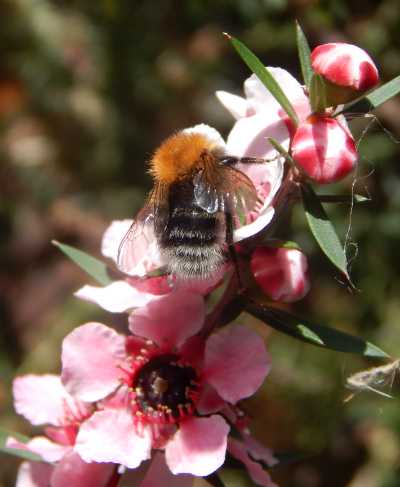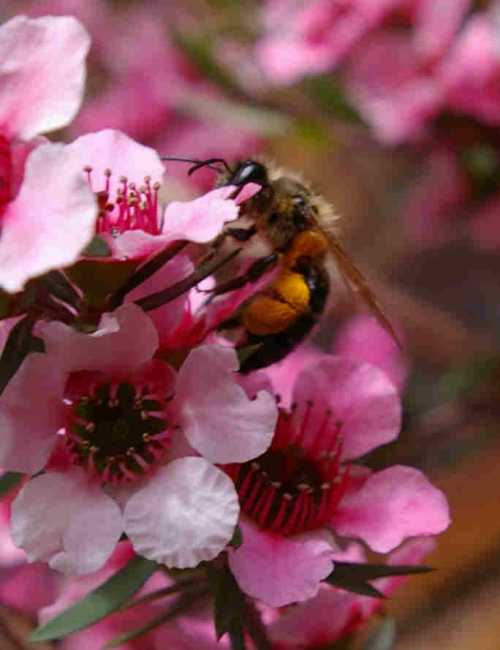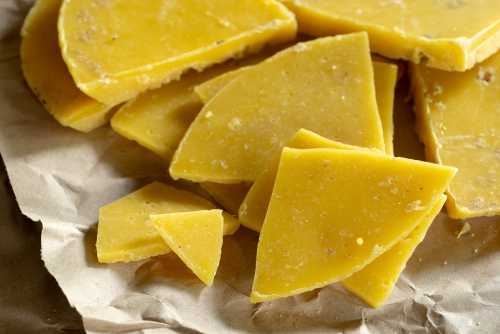What is Manuka Honey?
If you have seen Manuka Honey on the shelf in the supermarket or health store, you may be curious as to where it comes from, and what is so special or unique about it? So what is Manuka honey?
The short answer is:
Manuka honey is specifically produced by bees that only visit the manuka tree (Leptospermum scoparium) in New Zealand.
The bees that produce manuka honey are European honey bees (Apis mellifera) that were introduced into New Zealand. The manuka tree grows throughout New Zealand.
What are the characteristics of Manuka honey?
Manuka honey is a very viscous honey (that is, it seems to be very thick, and doesn’t flow easily) – and is probably the most viscous of all honeys.
It is a monofloral honey (produced by bees that have visited predominantly one species of plant - in this case the Manuka bush) but combinations can be found - you may see Manuka multifloral honey on the market. It has quite a dark colour – although it can vary from dark cream to dark brown.
The taste is described as earthy or slightly bitter, while some people describe it as being herbaceous or aromatic.
The Manuka Bush
Leptospermum scoparium has beautiful pink flowers oozing with nectar irresistible to bees.
 Bumble bees also love Leptospermum scoparium - this variety: 'Martini'. Commonly known as: Manuka or New Zealand tea tree, grows in our garden.
Bumble bees also love Leptospermum scoparium - this variety: 'Martini'. Commonly known as: Manuka or New Zealand tea tree, grows in our garden.
Leptospermum scoparium has also been introduced to other countries as an ornamental shrub.
I live in the UK, and have a very beautiful Leptospermum scoparium (pictured above and below). It gets covered in bees from end of May onwards, and the flowers are delightful.
Once the bees have had their fill and nectar secretions have reduced, the hover flies move in to lap up the residues.
This shrub needs a sheltered spot - ours grows against the sunny wall of our house. We originally had two of these shrubs, but the other was planted in an exposed position, and didn't survive a snowfall.
 The flowers are popular with honey bees but also a range of bees, including solitary bees. Hoverflies are also regular visitors.
The flowers are popular with honey bees but also a range of bees, including solitary bees. Hoverflies are also regular visitors.Interesting fact:
Leptospermum scoparium comes from the same plant order and family as the Tea Tree (renowned for its antiseptic and anti-bacterial properties):
Plant Order: Myrtales
Family: Myrtaceae
However, the Tea Tree belongs to the genus 'Melaleuca' found in Australia, whereas the Manuka or New Zealand Tea Tree belongs to the genus 'Leptospermum'.
Is Manuka Honey different from other honey?
There are a number of claims made about manuka honey with regard to health and clinical benefits. Some of these claims are explored in depth on other pages:
- New Zealand Manuka Honey and MRSA:
There is evidence that manuka honey may be effective against MRSA. - New Zealand Manuka Honey and wound care:
There is some evidence which could suggest that manuka honey may be effective in wound care in some circumstances (e.g. depending on bacteria type present within the wound). - New Zealand Manuka Honey and Acne:
Manuka honey is sometimes proposed as a remedy for acne, but so far, I have seen no clear, convincing clinical evidence that has proven manuka honey's efficacy for this skin condition - it seems more research is needed in this area. - Tualang Honey vs Manuka Honey:
A look at a paper that compared the two honeys.
Manuka honey controversies
There are two controversies surrounding manuka honey.
Adulteration
The
first controversy concerns the validity of the honey – is it genuinely manuka
honey from New Zealand, or is it adulterated?
To be labelled as manuka honey, at least 70% of the pollen content must be from the L. scoparium tree, which exists predominantly in New Zealand and so the New Zealand Manuka Honey production should represent almost all the world’s production.
However it is interesting to note that the New Zealand Manuka Honey manufacturers trade association (Unique Manuka Factor Honey Association - UMFHA) states that about 1,300 tons of manuka honey are manufactured each year (2013 data), and yet about 10,000 tons of manuka honey is sold worldwide each year.
In other words there is more Manuka Honey being sold than is actually being made!
Sample testing by UMFHA in UK, China and Singapore has revealed that some Manuka Honey is adulterated with syrup (about half of the samples they tested in 2012 / 2013).
It is not immediately clear how to tell when faced with a jar in a supermarket: whilst the colour can be seen, it is not possible to test the viscosity without purchasing a jar and opening it.
Is Australian Manuka Honey the same as New Zealand Manuka Honey?
The
second controversy surrounds Australian Manuka Honey versus its New Zealand cousin. Australian Manuka comes from bees feeding on the native Australian
Manuka plant or 'Jelly Bush' (Leptospermum polygalifolium - subspecies polygalifolium).
The plant is slightly different from its New Zealand cousin, but supporters say: "Australian Manuka Honey, has the same scientifically tested levels of non-peroxide activity and is rated according to levels of methylgyoxal – the active manuka factor"1.
However, John Rawcliffe, from New Zealand's Unique Manuka Factor Honey Association, said the word 'manuka' is a New Zealand word derived from the Maori language, and that New Zealand Manuka Honey is supported by research.
He also says:
"New Zealand manuka honey, believe it or not, it was first produced back in the 1840s in New Zealand and it's become famous because of the body of research that has been initiated in New Zealand."2
Clinical use of Manuka Honey
- The antibacterial properties of honey in general have been well documented.
It has been shown that, whereas the antimicrobial effect of non-manuka honey is due to a number of factors (including peroxide levels), with manuka honey it may be due to a component of the honey called methylglyoxate, although this has been disputed. - Although manuka honey has shown significant activity in some studies (including against MRSA) other clinical studies show mixed.
- There are some promising results in wound healing.
- As I write, more evidence would be needed to support use in acne (what does exist, seems to suggest manuka may not be beneficial for this condition - please get in touch if you learn of any new or conclusive evidence either way).
Some benefits that apply to manuka honey, can also apply to other honey variants.
For example,
- Honey in general has been found to be effective against cold sores and against the Herpes virus generally.
- Honey in general, is an effective anti-tussive, making it helpful in treating coughs.
Buying Manuka Honey
Certified, medical-grade manuka honeys are available.
You can also get manuka honeys with a guaranteed level of MGO but the benefits of more MGO may not be clear.
Given the fraudulent activity with regard to sale of honey labelled as manuka, it would be wise to conduct your own background checks. A higher price will not necessarily guarantee authenticity, and indeed, could be part of the deception.
References
(1) https://www.naturallife.com.au/en/natural-and-herbal-supplements/manuka-honey/
(2) http://www.abc.net.au/news/2016-12-29/manuka-honey-antibacterial-australia-new-zealand/8151996
If you found this page helpful or interesting, I'd really be grateful if you would share it with others - if not this page, perhaps another, such as Gardening For Bees.
Thank you so much :) .
